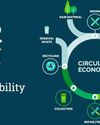Why Innovation-First Climate Tech Is the Future of Fashion Compliance
July 2025
|Textile Value Chain
The constantly evolving landscape of the fashion industry, from evolving silhouettes to fast-paced production cycles, grows on reinvention. However, one fact is becoming more and more obvious as the ecological problem worsens and governmental oversight increases: fashion can no longer afford to innovate solely in terms of aesthetics. The way it sources, creates and assesses its impact must change in the modern era. Climate technology and more especially innovation-first climate technology, is at the centre of this change and will serve as the foundation for fashion compliance in the future.

The Compliance Conundrum In An Evolving World
Compliance in fashion has been about ticking boxes: sticking to minimal standards around waste disposal, labour, or carbon footprints. But that static model is disintegrating. Globally, governments are releasing legislation that calls for more than just reports, i.e., real results. California's Climate Corporate Data Accountability Act, France's AGEC law, and the European Union's Corporate Sustainability Reporting Directive (CSRD) are some of the instances pushing brands to reveal and majorly minimise their environmental impact.
For fashion brands, this means shifting from qualitative storytelling to quantitative accountability. Instead of saying that your cotton is sustainable, you must be transparent in showcasing the data, that too in real time, to the regulators, customers, and investors. That's where innovation-first climate tech becomes vital.
 Why Fashion Can't Rely on Legacy Sustainability Tools
Why Fashion Can't Rely on Legacy Sustainability ToolsManual audits and conventional environmental management systems are not enough, as most of them are laborious, reactive, and fragmented, which is a poor match for the complicated, globalised fashion supply chain. Fashion brands usually depend on dozens (sometimes hundreds) of suppliers across several geographies, each with their own languages, standards, and data formats.
The ever-changing regulatory landscape and this degree of complexity are simply too much for legacy systems to handle. Even worse, a lot of systems continue to rely on third-party certifications, Excel sheets, or PDFs that barely scrape the surface of true impact. Brands run the danger of making false claims or failing to meet regulatory deadlines as a result, leaving them vulnerable to penalties, legal action and harm to their reputation.
هذه القصة من طبعة July 2025 من Textile Value Chain.
اشترك في Magzter GOLD للوصول إلى آلاف القصص المتميزة المنسقة، وأكثر من 9000 مجلة وصحيفة.
هل أنت مشترك بالفعل؟ تسجيل الدخول
المزيد من القصص من Textile Value Chain

Textile Value Chain
EPR in Textiles: Turning Compliance into Opportunity
When the EU Comes to Panipat, It Means One Thing — The World Is Watching
3 mins
November 2025

Textile Value Chain
European Parliament Delegation Visits Panipat Recycling Cluster to Strengthen India-EU Collaboration on Circular Textiles
A high-level delegation from the European Parliament's Committee on International Trade (INTA) visited the Panipat Textile Recycling Cluster — India's largest hub for recycled textiles and circular manufacturing — during their official visit to India.
1 mins
November 2025

Textile Value Chain
Paramount Instruments: Where Innovation Turns Testing into Joy
At Paramount Instruments, innovation isn't just a Pursuit- it's in our DNA.
2 mins
November 2025
Textile Value Chain
Crafting the Future: LMW & Hami Weavelon pioneer Compact Spinning in Polyester
Manmade fibres today form the backbone of the global textile industry, driven by their versatility, performance, and ability to meet the rising demand for both everyday and specialised applications.
3 mins
November 2025

Textile Value Chain
Data is the New Thread: Weaving India's Textile Sector into a Circular Powerhouse
On November 13, 2025, at the 12th Edition of the India and Sustainability Standards (ISS) International Dialogue and Conference held at Bharat Mandapam in New Delhi, representatives from the Home Exporters Welfare Association of India (HEWA) joined industry leaders, policymakers, and international organizations to address a pressing question: How can India's textile sector meet emerging global data requirements while supporting its MSME backbone?
3 mins
November 2025

Textile Value Chain
Rieter Winding Suction Nozzle Upgrade: More Yarn, Less Energy Use
After upgrading the suction nozzles on their 32 winding machines, Sanyang Textile Co., Ltd., China, saw an increase in yarn production of 3% and a reduction of 13% in energy use. The flow-optimised, aerodynamically designed suction nozzle enables efficient upper yarn search and pickup from the package. This results in a 55% reduction in red light percentage and a significant reduction in the operator's workload.
1 mins
November 2025

Textile Value Chain
EU's Extended Producer Responsibility (EPR) Law and Its Implications for India's Textile Industry
The European Union (EU) has approved a new Extended Producer Responsibility (EPR) framework for textiles. This is a major regulatory shift that makes fashion brands and producers accountable for their products' entire lifecycle, from design and production through collection, sorting, recycling and disposal.
9 mins
November 2025

Textile Value Chain
GTE Ahmedabad 2025 Concludes Day 3 with a Huge Footfall
The 38th Garment Technology Expo (GTE) Ahmedabad 2025, co-located with the Lace & Trims Show, wrapped up its third day on an impressive note, recording around 9,700 B2B visitors. The strong industry turnout reaffirmed the expo's role as one of the most influential and business-driven platforms for garment and apparel technology in the western region.
2 mins
November 2025

Textile Value Chain
Reinterpreting Korean Street Fashion through Sustainable Design Practices
A Path through Eco-conscious Urban Fashion
7 mins
November 2025

Textile Value Chain
3D Printing in Textiles Manufacturing: A Game-Changer in Design, Sustainability, and Efficiency
The global textile and apparel industry is undergoing a radical transformation due to the convergence of digital design, advanced material technology, and next-generation manufacturing. Of the latter, few have greater potential to change how textiles are made today than additive manufacturing, better known as 3D printing.
5 mins
November 2025
Listen
Translate
Change font size

